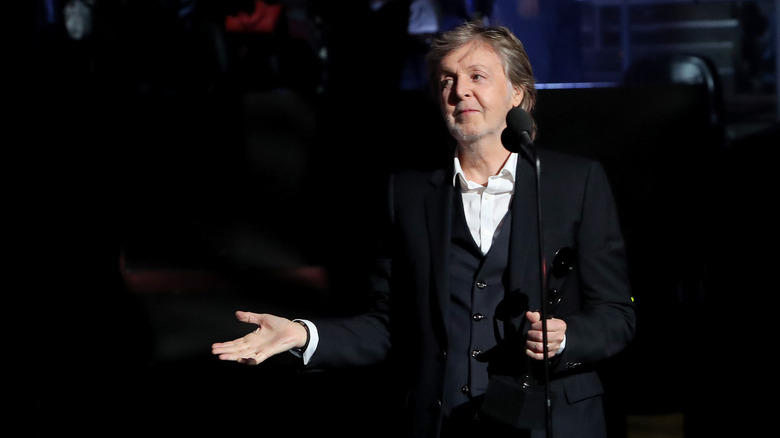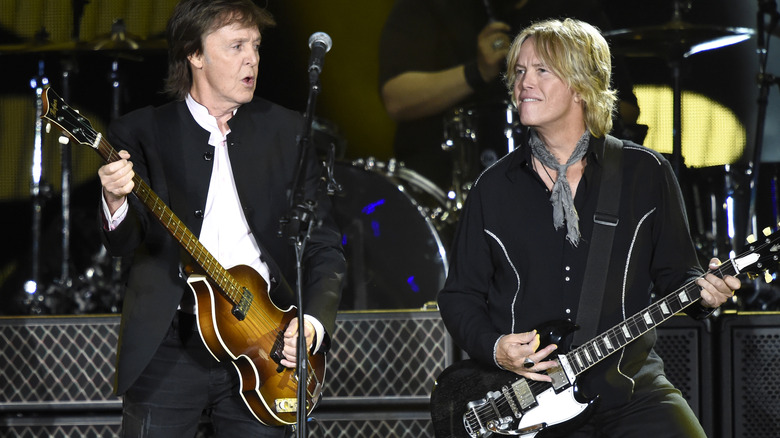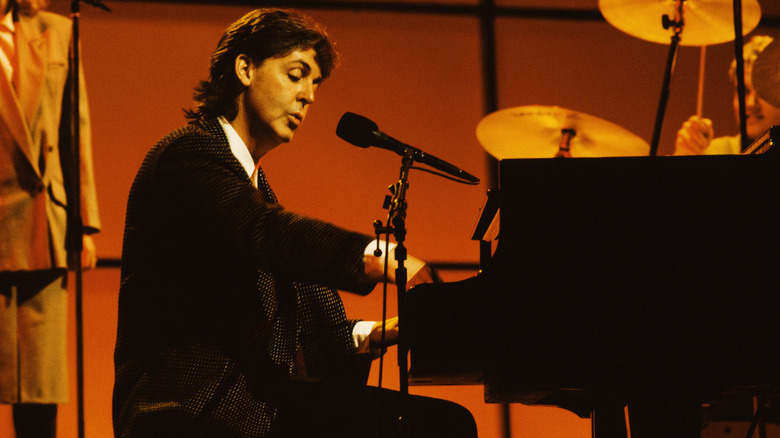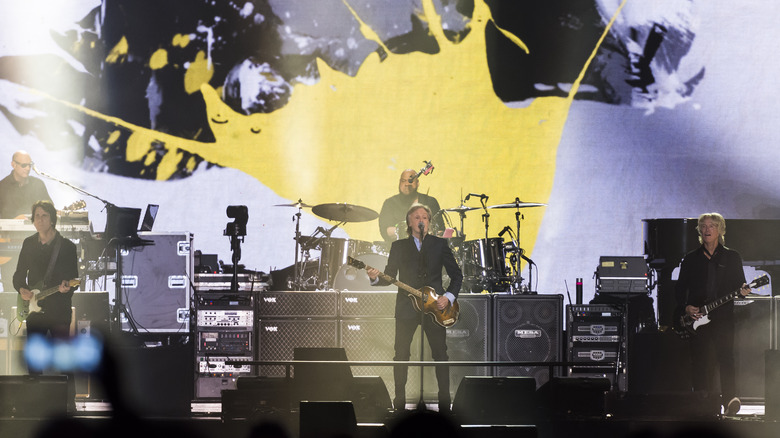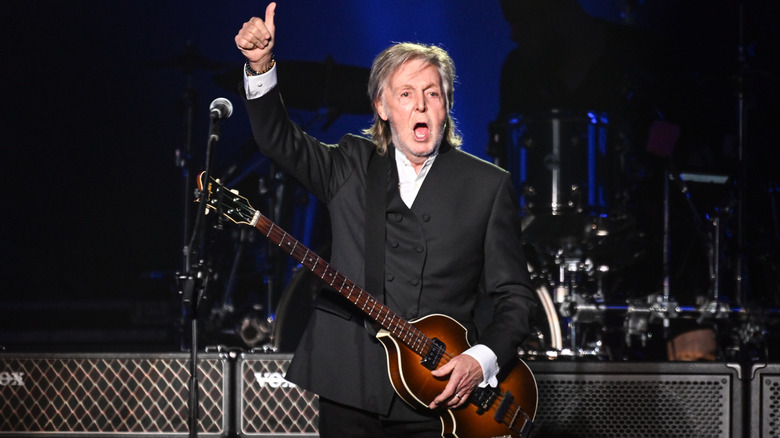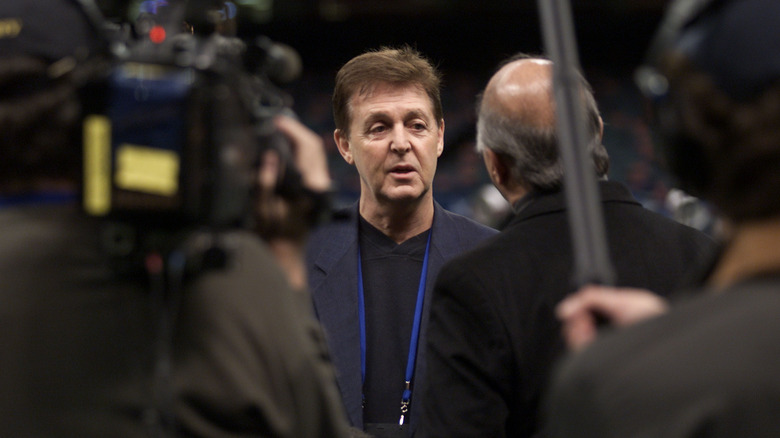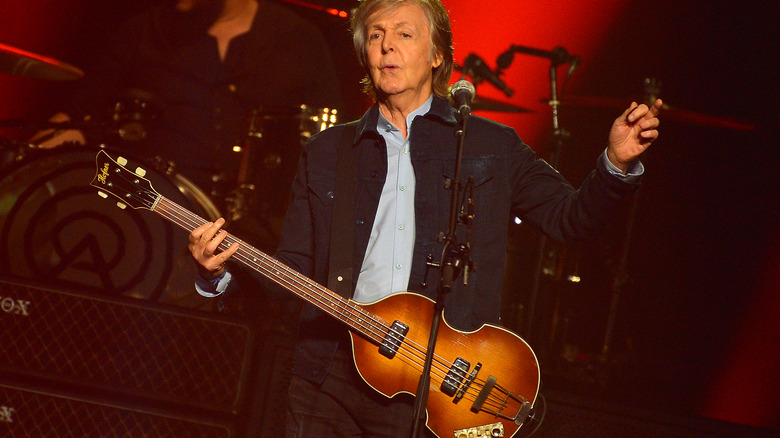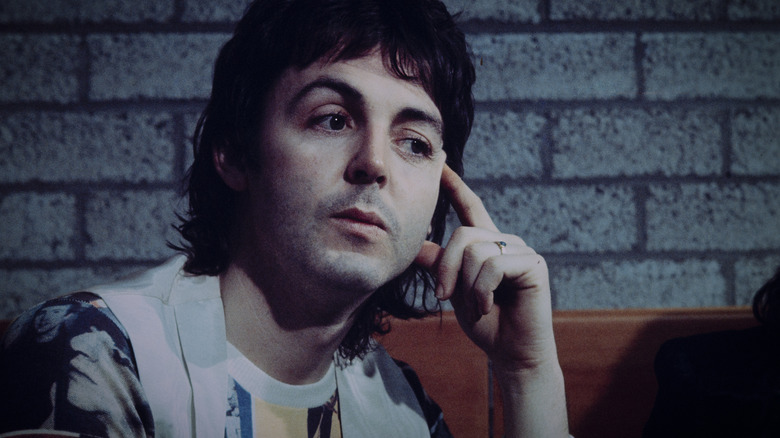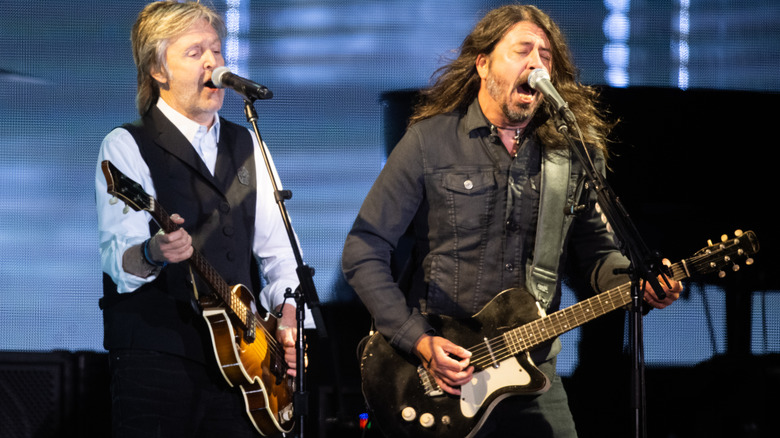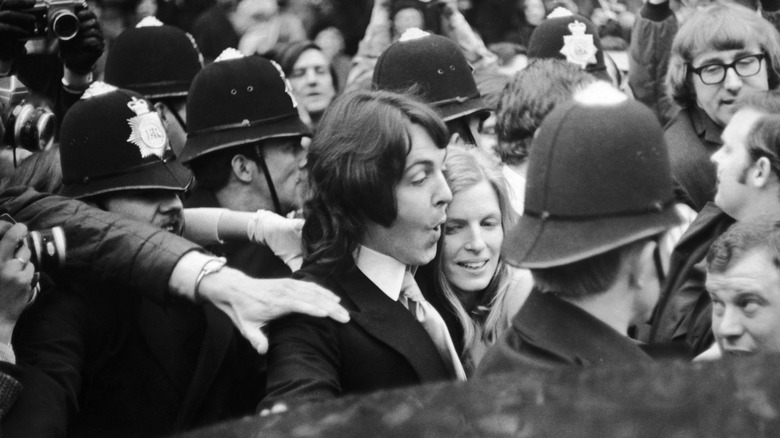Rules Paul McCartney Makes His Staff Follow
Getting someone to speak candidly about what it's like to work for Paul McCartney is apparently a little difficult, because most people are understandably content to simply sing his praises ... and a lot of them. That's not entirely surprising: Get hired by Paul McCartney — whether that's as a concert crew member, part of his backing band, or in makeup and wardrobe — and it's pretty much a guarantee that someone's at the top of their game.
Take it from band bassist Brian Ray. He's worked with McCartney for years, and told business culture consultant Stan Slap (via LinkedIn) that working for McCartney is pretty straightforward: "He is a great leader and a great boss. He wants the best out of people and he really gets it. Not because he's a tyrant in any way, because he certainly isn't, but because he stays on it. He throws down every time we play. He's going to step on the gas and reach deep every night ..."
And unsurprisingly, he expects the same from those who work for him. Ray lauded McCartney for his method of leadership, which is basically hiring the best, treating them right, and getting the best out of them. Simple, right? He remembers people, too: In 2004, one of the makeup artists who worked with the then up-and-coming Beatles ahead of their appearance on "The Ed Sullivan Show" re-introduced herself to McCartney. He not only remembered her, but remembered the reassurances she'd given him ahead of the show. "I was blown away," Riccie Johnson told CBS. Even the best leaders, however, have their rules.
Be ready for anything, because you're not playing the same thing over and over
When author and business culture expert Stan Slap wanted to learn how employers secured an all-in, bend-over-backward sort of commitment that's often reserved for the kind of family that a person actually loves, he spoke with Paul McCartney band bassist Brian Ray for his book, "Under the Hood" (via LinkedIn). Ray confirmed that it wasn't just about hiring the best, most technically gifted people or finding those who were able to play McCartney's back catalog flawlessly and then putting them up on stage. Instead, McCartney requires something more of anyone thinking of joining his band: The ability to change things up on the fly, relate to other musicians in an instant, and not miss a beat when something changes.
"Anything can happen. Paul likes to rock. We are not playing to Pro Tools, pre-taped material, or time references. We're not tethered to anything but each other up there. ... We are sharing a live, musical experience like real musicians have always done, and it requires you to have visual and audio connection with each other. It is an immediate, vital music experience for Paul's band."
Things go wrong, of course, and when they go wrong in front of a crowd of tens of thousands of people, Ray says McCartney expects his people — band or crew — to get it fixed, well, yesterday. The result isn't just amazing shows, and Ray says that playing with McCartney "had made me a better musician, and he has made me a better human being."
There's a lot of waiting in the studio, but everything has to be ready to go
When Kylie Olsson sat down to talk to musician Brian Ray about his incredibly long, incredibly wild career, the conversation naturally turned to what it was like to work with Paul McCartney in the studio. At the time, they'd been working together for two decades, and Ray said, "Yes, you can call him my boss, but he's more than that." Look at it this way: Bands don't stay the same for that long without some serious trust, and Ray says that a lot of that has to do with what happens when they set foot in the studio.
And it's a huge process. Ray says that McCartney expects his people to set up an almost shocking number of instruments, saying that it's not about what he's planning on playing in any given session, but what he might want to play. And that includes multiple pianos — from grand pianos to uprights and beyond — along with a slew of keyboards, multiple synths, and guitars? There are some stores that aren't as well-stocked as a McCartney studio session.
"They're all set up, and mic'd, and ready to go, because he might want to play a piano, then jump over to acoustic guitar, back-to-back, and you've gotta be ready." Ray says that it all has to do with the way he works, and that if something pops into his head, he'll want to record it that second. It really is watching a genius at work: "And that requires everyone to be on their toes."
You'll have to be all right with going vegetarian
Paul McCartney is about as famous for his vegetarian ways as he is for his music, and when he spoke with The Guardian in 2010, he not only shared some of his favorite recipes (steamed vegetables and hummus), but he also shared the fact that he wrote to the Dalai Lama to convince him to become vegetarian. It's not entirely surprising then to find out that one of the rules he has in place is that, when he's catering for the crew working on setting up his shows, those meals are being served in a meat-free zone.
That same year, McCartney made it clear that anyone working on his Up and Coming Tour was expected to go meatless, and when McCartney put on a Canadian show at Regina's Mosaic Stadium, he felt so strongly about it that a vegetarian menu had been one of the conditions of the show. Fast forward to 2017, and Perth Now reported that his Australian shows had gotten even more strict: A crew member reported, "All the crew members have to eat vegan food. No one's allowed to eat meat for three weeks on site. It has to be vegan food."
They, too, stressed that McCartney had made it clear that he wouldn't be going on stage unless he was guaranteed his menu would be adhered to, and people haven't always been happy about it. In 2004, crew members complained to local newspapers (via Today) that they were being expected to work 12-hour days on strictly vegetarian meals.
There's no leather clothing or furniture allowed, either
Ask most stage workers and they'll tell you that one of the most important pieces of clothing they wear is a good pair of heavy leather boots, but work for Paul McCartney, and that's just not going to happen. According to workers setting up for one of his European concerts in 2004, they were under strict instructions not to wear any leather, including shoes or belts. In 2017, Perth Now reported that zero-tolerance policy for animal products also extended to backstage furniture and his cars, and it had been that way for years.
When The Smoking Gun got a copy of McCartney's concert rider, it not only confirmed the meat-free meal policy that extended to anyone backstage or in production offices, but also that the limousine that was requisitioned for his use was definitely not to have leather seats. It was also specified that it was incredibly important that when backstage and dressing rooms were being furnished, that no materials sourced from animals were used.
And that makes sense. Why go vegetarian and vegan for animal rights, and then use hide-covered furniture? But strangely, there's one more step to the rules and requirements for those furnishing a McCartney concert. He also insists that there's no faux animal skin, fur, or prints, either. Those working backstage were expected to have all the proper furniture in all the proper rooms ... animal-free, and whether or not it's real or fake doesn't matter. It's a no-go.
He has some guidelines in place for those running his social media
Check out Paul McCartney's Facebook page or Instagram, and at a glance, it seems pretty standard fare for someone of his status. There are plenty of throwback photos, concert photos, and photos of him in the studio and at events ... but according to what he told GQ, he actually has some instructions in place for his social media team.
Those following his pages won't see anything super personal, aside from the occasional birthday or anniversary snap — and that's by design. McCartney says that he trusts his team to run things most of the time, "and when I do dip in I kind of enjoy it, especially when something important has happened," he explained. But mostly? "I'd rather just go off into a corner and try to write a song."
He also says that it's important to him that no one gives too much of his personal, private life away when they're posting for him. He's not going to be promoting a hot new restaurant, publishing pool-side snaps, or (perhaps surprisingly) sharing some of those vegetarian recipes he's so fond of. Those restrictions are for good reason: "Why would I want to tell anyone where I was? Why would I want to tell them what I'm eating?" he asked. "... That's private, otherwise, you don't have any private life." He suggests that it was easier to be famous during the heyday of The Beatles: Sure, everyone knew who they were, but behind closed doors, they still had their own, private lives.
His wardrobe team have to keep everything immaculately labeled
Gina Vincenza Van Epps is an Emmy-winning seamstress, and when she worked with Paul McCartney in 2013, it was for the second time. She'd come a little further along in her career, though, and this time, she was given an inside look at his wardrobe department as it was set up for a concert in Orlando, Florida. In the process, she learned that part of what he required from his wardrobe staff took some serious commitment to organization and some meticulous record-keeping.
She posted in an entry on her Psycho Seamstress blog that while she was doing pretty standard stuff — like checking over garments to make sure there was no mending to cleaning required, and steaming jackets and pants — she found that part of what was required of the wardrobe department was to keep everything immaculately and completely labeled with not only where and when it was worn, but what coordinating shirts and accessories went with it.
"The hang tags document his White House performance, his appearance on Saturday Night Live, Charity Events, and Concert dates from 2010 to present," she wrote, and added that there was a very good reason for this. The wardrobe people had to be so meticulous because there was a good chance his clothes would be donated to museums or auctioned, and institutions wanted the provenance to go along with that. And things can go for a lot of money: In 2004, a suit that McCartney wore in 1964 sold at Christie's for a whopping $53,775, which was about six times the estimated value.
Everything has to be consistently beyond spotless
Gina Vincenza Van Epps — aka, the Psycho Seamstress — posted on her blog in 2013 and described her experiences working for Paul McCartney behind the scenes of his Orlando, Florida concert. She shed some light on just what kind of expectations he had for those working on the ground to get dressing rooms and backstage offices set up and ready for him, and it's not for anyone who doesn't have a degree in being meticulous.
Part of her job was to set up his personal items, and to make sure the spaces he would be using were spotless. And "spotless" is kind of an understatement. That meant doing things like putting down his personal bathroom mats, making sure there were no fingerprints or footprints on any of the surfaces, making sure there was no garbage left behind anywhere (including trash cans), and by the second day, the to-do list was even longer.
Just some of the things that McCartney expects his people to be doing include flowers being replaced regularly and everything to be re-cleaned — with fingerprints and footprints removed. There was a level of security here, too. Van Epps also noted that she was tasked with escorting the cleaning staff to not only make sure everything was up to standards, but also to make sure that there were no photos taken of the private rooms and things weren't disturbed. Each day McCartney was there, everything was re-cleaned and freshened up, while problems — like blankets that had folds and creases — were expected to be corrected.
Don't bring the same old ideas
Paul McCartney might be widely lauded as one of the best musicians not only of his era, but of any era, but that doesn't mean he's content to rest on his laurels. When Billboard took a look at what goes on behind the scenes of his empire, they said that a lot of it has to do with the fact that around the breakup of The Beatles, he formed his own company, MPL. It has been those employees who have been responsible for his continued success, and he credits them for it. But he also says that he holds them to one seemingly simple but very complicated rule.
"I've got a great team, and my main thing is: Let's try and keep it exciting." Easy right? That's debatable, maybe, and it's the sort of thing that's easier said than done. It's also why fans see him teaming up with people like Kanye West, and appearing on albums with other performers.
And it's about more than just musical collaborations, and Forbes has called McCartney "The Master of Content Marketing." It's also why you see him on Carpool Karaoke, it's why he and Jimmy Fallon surprised random people by getting on an elevator, and it's why he's consistently reaching out to the younger crowd with various appearances, collaborations, and interviews. In other words? He wants everything to stay fresh and relevant, and when his team of people sit down to hash out the next big idea, they'd better be thinking outside the box.
Security has to keep it quiet and calm
Watch any old footage of crowds at the height of Beatlemania, and it's nothing but mayhem: People are pushing and shoving, screaming, all vying for a word, a glance, and some? Some very clearly want more than that, and it's kind of amazing that the Beatles were able to get anywhere without getting grabbed and carried off, mosh pit-style. All that chaos has taught Paul McCartney some very important lessons about crowd control, and according to what he told the BBC, it's impacted the instructions he now gives his security detail.
"What happened occasionally was you had security guys who would growl, 'Get out of the way! Move out of the way!' and the crowd would get a bit aggressive," he explained. That would sometimes have the opposite effect, "So we learned to keep moving forward and be very quiet and calm about it — out of necessity, to not make a crazy scene any crazier."
And it makes sense: Getting hostile and denying fans (who may have been waiting for hours) a glimpse of their idol would just add fuel to the fire, and no one wants that. Now, McCartney says that he and his security team have a rhythm: Move through the crowd, slowly, purposefully, with no fuss, and absolutely no hostility. He says he's more than happy to greet people, but adds that he's going to keep moving — and that's how you get through a crowd without making chaos even more chaotic or, even worse, dangerous.
